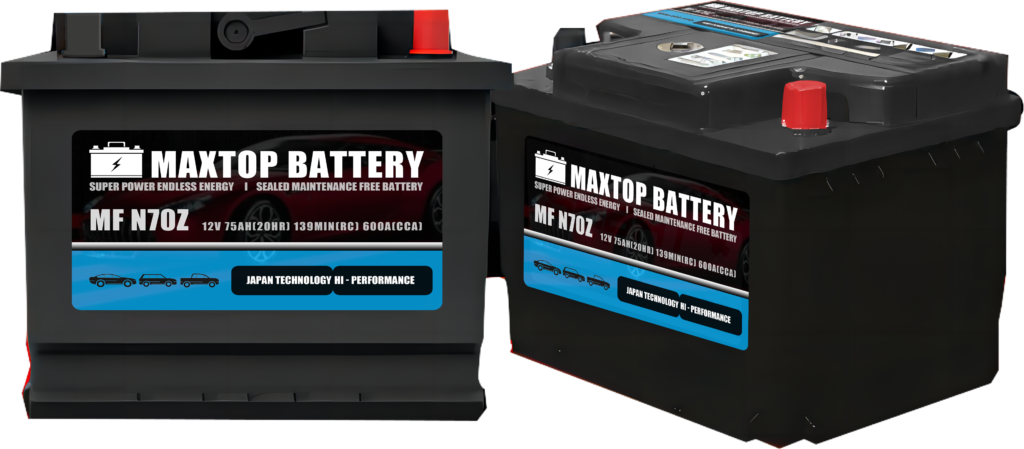

10+TOP FACTORS TO KEEP IN MIND WHEN BUYING A CAR BATTERY
LEAD-ACID BATTERY: One of the most common types of car batteries is the lead-acid battery. This battery is composed of lead dioxide, lead, and sulfuric acid. The sulfuric acid acts as an electrolyte, producing a chemical reaction between the lead and lead dioxide that generates electrical energy. The battery consists of a series of cells, each containing a positive and negative plate, separated by an insulating material. When the battery is fully charged, the plates are covered in lead dioxide and lead sulfate. When the battery discharges, the lead sulfate is converted back to lead and lead dioxide, and the sulfuric acid is consumed.
GROUP SIZE: Car batteries come in a variety of sizes and types, depending on the vehicle’s make and model. Group size refers to the standardized battery size used for a specific vehicle. This determines the physical dimensions and placement of the battery in the vehicle. For example, a small car may use a Group 24 battery, while a larger truck may require a Group 31 battery.
CAPACITY: One of the most important factors to consider when choosing a car battery is its capacity. Capacity refers to the amount of electrical charge a battery can store, typically measured in ampere-hours (Ah) or milliampere-hours (mAh). A higher capacity battery can deliver more electrical energy and will last longer before needing to be recharged.
VOLTAGE: Another important factor to consider is the battery’s voltage. Battery voltage is the measure of electrical potential difference between the positive and negative terminals of the battery, expressed in volts. The voltage determines the battery’s ability to start the engine and power the vehicle’s electrical systems.
CA & CCA: Cranking amps (CA) and cold cranking amps (CCA) are two key terms related to a battery’s ability to start an engine. CA measures the number of amps a battery can deliver for 30 seconds at 32 degrees Fahrenheit without dropping below 7.2 volts. CCA measures the number of amps a battery can deliver for 30 seconds at 0 degrees Fahrenheit without dropping below 7.2 volts. A higher CA or CCA rating means the battery can deliver more electrical energy and is better suited for cold weather conditions.
RESERVE CAPACITY: Reserve capacity (RC) is another important term to consider when choosing a car battery. RC refers to the number of minutes a fully charged battery can deliver 25 amps of current at 80 degrees Fahrenheit before dropping below 10.5 volts. This measures the battery’s ability to power the vehicle’s electrical systems in the event of an alternator failure.
MAINTENANCE-FREE BATTERY: Maintenance-free batteries are a popular choice for many drivers. These batteries are sealed and do not require adding water to the cells. While they are convenient, they may not last as long as traditional lead-acid batteries.
DEEP CYCLE BATTERY: Deep cycle batteries are another type of battery commonly used in marine and RV applications. These batteries are designed to be discharged and recharged repeatedly and have a higher capacity than traditional car batteries.
LITHIUM-ION BATTERY: Lithium-ion batteries are a newer type of battery that uses lithium ions to carry electrical charges between the positive and negative electrodes. These batteries have higher energy density and longer lifespan than lead-acid batteries but are more expensive.
TERMINALS: Battery terminals are the metal connections on top of the battery where the cables are attached. These are usually marked positive (+) and negative (-). Polarity refers to the positive or negative charge of a battery or electrical circuit. In car batteries, the positive terminal is marked with a plus sign (+), and the negative terminal is marked with a minus sign (-).
ELECTROLYTE: The electrolyte is the liquid mixture of water and sulfuric acid in a lead-acid battery
The electrolyte facilitates the chemical reaction between the lead and lead dioxide plates to generate electrical energy. It is important to maintain the proper level of electrolyte in a lead-acid battery to ensure proper function.
BATTERY LIFE: Battery life refers to the amount of time a battery can function before needing to be replaced. The lifespan of a battery depends on a variety of factors, including usage patterns, environmental conditions, and maintenance.
BATTERY RECYCLING: Battery recycling is an important consideration when it comes to car batteries. Lead-acid batteries contain toxic lead and sulfuric acid, which can be harmful to the environment if not disposed of properly. It is important to recycle used car batteries to prevent pollution and conserve resources.
BATTERY CHARGER: Battery charger is a device used to recharge a discharged battery. There are a variety of battery chargers available, including trickle chargers, which slowly charge a battery over time, and rapid chargers, which can quickly recharge a battery in a matter of hours.
BATTERY LOAD TESTER: Battery load tester is a device used to measure a battery’s ability to deliver electrical energy. This is done by applying a load to the battery and measuring the voltage drop. A battery with a low voltage drop indicates a strong battery, while a high voltage drop indicates a weak battery.
EQUALIZATION: Equalization is a process used to balance the charge in a battery’s cells. This is done by applying a higher voltage to the battery to promote the conversion of lead sulfate back to lead dioxide and lead. This helps to restore the battery’s capacity and extend its life.
SULFATION: Sulfation is a common problem that occurs when lead sulfate builds up on the battery’s plates, reducing its ability to deliver electrical energy. This can be caused by prolonged storage or a low charge state. Sulfation can be reversed by charging the battery and applying an equalization charge.
OVERCHARGING: Overcharging is a problem that can occur when a battery is charged at a rate that is too high or for too long. This can cause the electrolyte to boil and damage the battery. It is important to use a charger that is designed for the specific type of battery and to monitor the charging process carefully.
UNDERCHARGING: Undercharging is another problem that can occur when a battery is not fully charged. This can lead to sulfation and reduce the battery’s capacity. It is important to maintain the proper charge level in a battery to ensure proper function.
In conclusion, car batteries are a vital component of every vehicle. Understanding the key terms and concepts related to car batteries can help you choose the right battery for your vehicle and maintain it properly for optimal performance and longevity. Whether you choose a traditional lead-acid battery or a newer lithium-ion battery, proper care and maintenance are essential to ensure reliable operation and prevent premature failure. Remember to always recycle used batteries to protect the environment and conserve resources.

